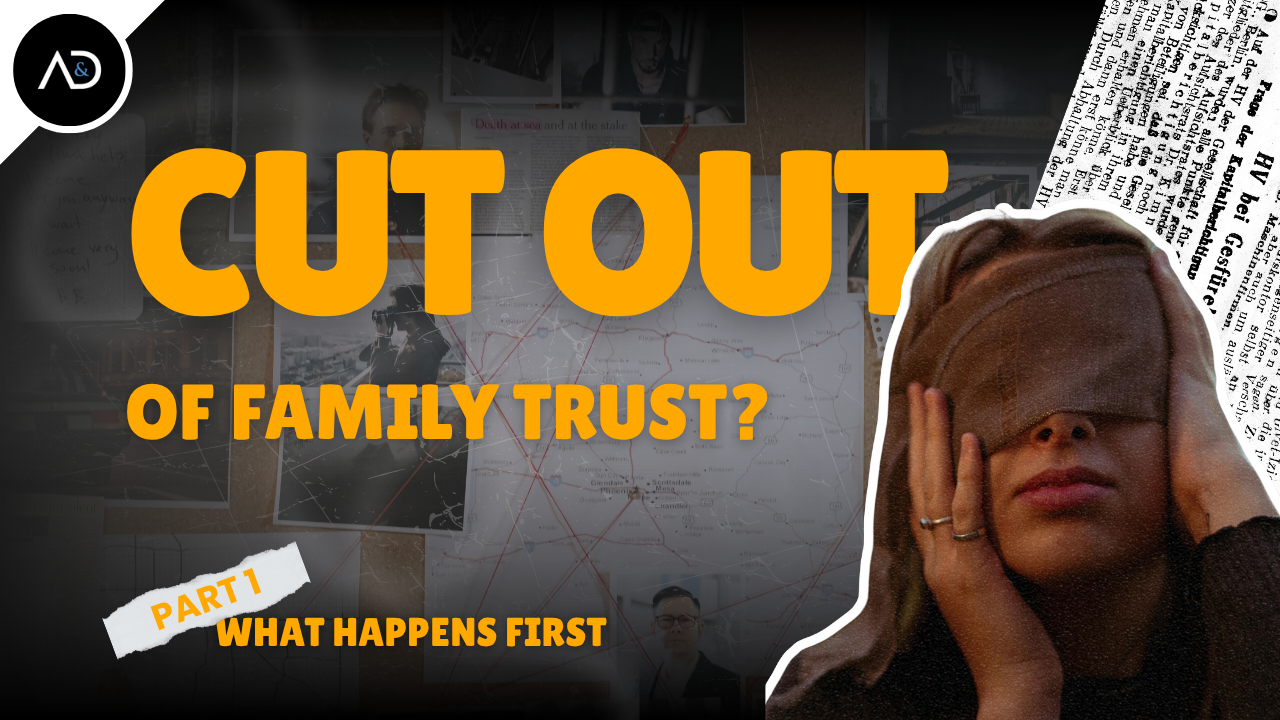
Part 1: What Happens First
The worst has happened. Your mother has passed away, and soon after, a copy of her Trust arrives in the mail from the Trustee. The cover letter says you have 120 days to contest the Trust, and enclosed is a copy of the trust instrument and a trust amendment.
You were always told—and always believed—that your parents’ Trust would be divided equally among their three children. One-third to each. It was supposed to be your financial cushion, your parents’ legacy to you, and their final act of love and fairness.
But as you read the Trust, your heart sinks. A recent amendment, signed just a few months before your mother’s death, leaves everything to your oldest brother — who also happens to be the Trustee. You’re left with a single bequest: $10,000.
Confusion, anger, disbelief, and betrayal flood in. Your mother would never have done this, you think. She loved you all equally. You try calling your brother, but he ignores you. His only text reply says: “This is what Mom wanted.”
It doesn’t make sense. Your brother lived with your mother for the last six years “to help her.” Now it appears he helped himself.
How can you fix this mess?

Step 1: Understanding the Beginning of a Trust Dispute
After handling trust and will contest cases for over 25 years, I’ve seen this story play out countless times. The names and details change, but the pattern rarely does.
A trust litigation case often begins with a suspicious change to a parent’s estate plan—usually made late in life, after one child gains control or influence. These changes often lead to bitter litigation and lasting family divisions.
If you suspect wrongdoing, your first step is to gather the documents. You’ll need:
-
The original trust your parents created.
-
Any amendments or restatements.
-
If a new trust replaced the old one, copies of both versions.
Step 2: Getting the Trust Documents (and Why It’s Hard)
It’s common for trustees to resist providing all the trust documents. Sometimes they’ll only send you the last version of the Trust — and under California law, they might be within their rights.
Under California Probate Code §16060.5, the trustee must provide the “terms of the trust” to beneficiaries and heirs. That includes the trust instrument and any amendments that affect the current distribution of assets. But the law does not require trustees to provide older or superseded documents that were replaced by a later restatement.
That creates a practical problem: you can’t tell what changed unless you can see what the plan looked like before. For example, maybe the original trust divided everything equally — and the recent amendment cut you out entirely. You can only prove that by seeing the prior trust version.
Fortunately, once you file a trust contest lawsuit, you can subpoena the documents. Section 16060.5 only limits what trustees must voluntarily disclose — not what you can obtain through the power of the court.

Sometimes trustees or their lawyers cooperate and share old versions voluntarily, knowing they’ll have to produce them later anyway. But just as often, they refuse. In my experience, about half of all cases start with a fight just to get the trust paperwork.
Step 3: Deciding Whether to File a Trust Contest
Once you’ve reviewed what you can, you must decide whether to file a trust contest.
If you’ve been completely disinherited, this decision is usually straightforward. You have nothing to lose.
But if you’re still receiving something under the Trust — and there’s a no-contest clause — you’ll need to think carefully before filing.
A no-contest clause is designed to discourage challenges. It typically says that any beneficiary who contests the Trust will lose whatever they were otherwise entitled to receive. California law limits how strictly these clauses can be enforced, but they still carry risk.
Let’s look at two examples:
- Example 1: You were supposed to get $3 million (one-third of a $9 million estate), but a new amendment reduces your share to $2.7 million. Contesting might not be worth the risk — if you lose, you could walk away with nothing.
- Example 2: The amendment cuts your share from $3 million to $250,000. In that case, contesting might make sense. Losing $250,000 hurts, but not as much as losing $2.75 million that should have been yours.
If you’re completely disinherited, the decision is easy — there’s nothing left to lose.

This is part 1 of our series on what happens when you’re cut out of a family trust. In part 2, we’ll cover what happens after you decide to fight back — how trust contests work, what strategies matter most, and how these cases play out in court.
If you’re unsure whether you need legal help, consider scheduling a free consultation with an experienced probate lawyer. A good lawyer can quickly assess your situation and guide you on the best course of action.

